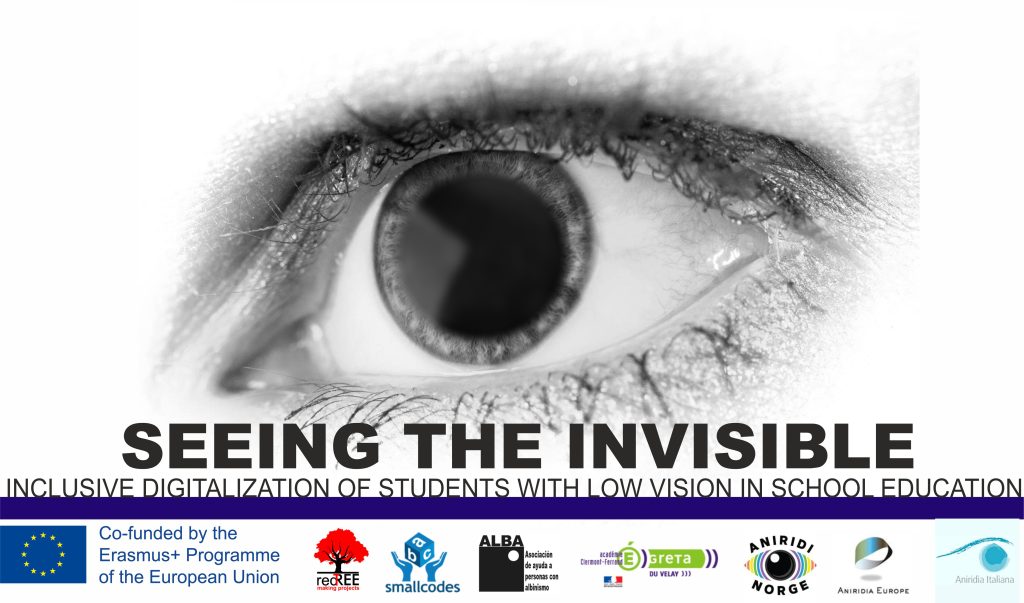Aniridia Europe participates on a new project on school inclusion of low vision students.

Background:
According to studies by the WHO (2020) and the participating entities themselves, it is estimated that there are more tan 2 million children under 15 years old with severe low vision or blindness in Europe.
They are boys and girls with severe visual impairment (usually aggravated by other pathologies which are the cause of the vision loss) of school age who struggle each day to live a full life… but this is not easy.
This is not easy for their teachers either; when a teacher receives a student with low vision in their classroom, he/she knows that all previous work, all his/her teaching experience, is not enough.
Every year they have to start again creating a new adapted classroom planning, new learning methods that include the student with low vision, rework all her educational materials to adapt them to low vision, invest many hours in the creation of curricular adaptations… and they usually don’t know how to do it, feeling helpless and alone, and not knowing who to turn to or ask for help. Primary school teachers usually haven’t received general training in attention to diversity, and never one specific to low vision; secondary teachers much less.
If this was the case before 2020, and nowadays COVID-19 has made this task of the teacher simply unfeasible. The pandemic has accelerated the process of digitization of schools, undoubtedly a step forward in the education of the future, but this advance also entails an increase in the teacher’s workload and a serious risk for students with low vision if carried out incorrectly. The teacher of a student with low vision now has to invest his/her already scarce time in digitizing their teaching, adapting classroom methods to COVID-19, digitizing resources, monitoring their students to see if there is contagion, and all of this fully adapted to low vision and not knowing how to do it. The only opportunity for the teacher not to lose dedication to students with low vision while also adapting teaching methods to the digital field (essential in the post-COVID-19 society) is to unify these two processes, generating innovative digital learning methods adapted to students with low vision, that have not just innovative and adapted tools, but also specific training and the creation of support networks of experts and families that allow them to achieve this.
Thus, we propose the project “SEEING THE INVISIBLE: Inclusive digitalization of low vision students in school education” both for teachers and students with low vision; a project that will generate digital and adapted tools to enable any school education student with low vision to achieve full inclusion in the classroom and educational success, regardless of whether teaching is on-site or online.
Partners
The 2022-2024 project “SEEING THE INVISIBLE: Inclusive digitalization of low vision students in school education” comes from the joint work of a wide multidisciplinary European network formed by social cooperatives expert in inclusive methodologies (Redtree Making Projects Coop.V.), virtual environment programming companies (SmallCodes Srl.), associations of low vision experts (the European federation of Aniridia – ANIRIDIA EUROPE, Aniridia Norway, Aniridia Italy, and the Spanish association to support persons with Albinism – ALBA), and schools themselves (more than 14 educational centers that form the GRETA DU VELAY network) from 4 countries (Spain, France, Italy, and Norway).

Objectives
Through a process of analysis of needs, in which students with low vision of the participating social entities and their teachers identified not only their needs but also made proposals for tools and resources that they would like to have in their classroom, not only the purpose of the project was determined, but also the specific objectives that would satisfy the needs detected.
Thus, SEEING THE INVISIBLE was born with the objective of providing teachers of students with low vision with the necessary tools to answer to the needs that they face when teaching in school classrooms with students with low vision in the international post-COVID-19 reality.
More specifically, we want to:
Provide specific training about low vision for teachers, to allow them to understand the capabilities of their students, the consequences of their rare diseases and low vision, and learn about effective teaching processes adapted to this beneficiary group.
Promote an inclusive, innovative, adapted, and appealing school education for students, whether or not they have low vision, by turning their smartphone into a powerful tool that teachers can use both to teach lessons (using the users’ own APPs) and to adapt their didactic programming to the beneficiaries and the virtual context in a simple way.
Facilitate the use of adapted digital materials that enable teaching and avoid having to reconstruct all the teaching materials created for on-site teaching throughout years of experience.
Promote the active participation of experts, doctors, and families of students with low vision in the work of the teacher, being a continuous support and avoiding the fear of making mistakes in their educational work.
Raising awareness in the educational community on the importance of adapting schools to persons with low vision (both students and potential teachers with this condition), not only structurally but through their work methods and support. We want to offer teachers everything they need to ensure that any school education student with low vision achieves full inclusion in the classroom and educational success, regardless of whether the teaching is on-site or online, and give them confidence, security, and tranquility to face the hard times he/she is living as a teacher.
